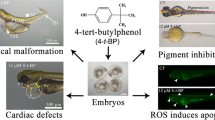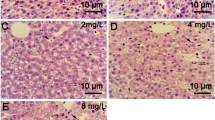Abstract
BPA is so ubiquitous that 27 million tons of BPA-containing plastic, including mineral water bottles and baby bottles, is produced worldwide each year. The potential toxicity of BPA to humans and aquatic organisms has been the subject of intense research. In this study, a zebrafish model system was used to assess BPA-mediated hepatotoxicity. Zebrafish larvae at 72-144 hpf were exposed to BPA at different concentrations (0,1, 3 and 5mg/L). For example, BPA-treated zebrafish larvae showed increased mortality, delayed uptake of nutrients in yolk sac, shortened body length, smaller liver area, abnormal expression of genes related to liver development, and pathological changes in the liver tissue. Mechanistically, BPA exposure induced excessive oxidative stress in the liver of zebrafish and increased the level of hepatocyte apoptosis in zebrafish larvae, and the antioxidant astaxanthin could rescue the BPA-mediated liver toxicity.






Similar content being viewed by others
Data availability
The original contributions presented in the study are included in the article/Supplementary Material; further inquiries can be directed to the corresponding authors.
References
Abdulhameed AAR, Lim V, Bahari H, Khoo BY, Abdullah MNH, Tan JJ, Yong YK (2022) Adverse effects of bisphenol a on the liver and its underlying mechanisms: evidence from in vivo and in vitro studies. Biomed Res Int 2022:8227314. https://doi.org/10.1155/2022/8227314
Ali SS, Ahsan H, Zia MK, Siddiqui T, Khan FH (2020) Understanding oxidants and antioxidants: classical team with new players. J Food Biochem 44(3):e13145. https://doi.org/10.1111/jfbc.13145
Babu S, Uppu S, Claville MO, Uppu RM (2013) Prooxidant actions of bisphenol A (BPA) phenoxyl radicals: implications to BPA-related oxidative stress and toxicity. Toxicol Mech Methods 23(4):273–280. https://doi.org/10.3109/15376516.2012.753969
Bambino K, Chu J (2017) Zebrafish in Toxicology and Environmental Health. Curr Top Dev Biol 124:331–367. https://doi.org/10.1016/bs.ctdb.2016.10.007
Berczi I (1993) Neuroendocrine defence in endotoxin shock (a review). Acta Microbiol Hung 40(4):265–302
Elswefy SE, Abdallah FR, Atteia HH, Wahba AS, Hasan RA (2016) Inflammation, oxidative stress and apoptosis cascade implications in bisphenol A-induced liver fibrosis in male rats. Int J Exp Pathol 97(5):369–379. https://doi.org/10.1111/iep.12207
Gaweł S, Wardas M, Niedworok E, Wardas P (2004) Malondialdehyde (MDA) as a lipid peroxidation marker. Wiad Lek 57(9-10):453–455
Gebhardt R, Matz-Soja M (2014) Liver zonation: Novel aspects of its regulation and its impact on homeostasis. World J Gastroenterol 20(26):8491–8504. https://doi.org/10.3748/wjg.v20.i26.8491
Ginsberg G, Rice DC (2009) Does rapid metabolism ensure negligible risk from bisphenol A? Environ Health Perspect 117(11):1639–1643. https://doi.org/10.1289/ehp.0901010
Goessling W, Sadler KC (2015) Zebrafish: an important tool for liver disease research. Gastroenterology 149(6):1361–1377. https://doi.org/10.1053/j.gastro.2015.08.034
Gu Y, Han J, Jiang C, Zhang Y (2020) Biomarkers, oxidative stress and autophagy in skin aging. Ageing Res Rev 59:101036. https://doi.org/10.1016/j.arr.2020.101036
He, J. H., Guo, S. Y., Zhu, F., Zhu, J. J., Chen, Y. X., Huang, C. J., . . . Li, C. Q. (2013) A zebrafish phenotypic assay for assessing drug-induced hepatotoxicity. J Pharmacol Toxicol Methods 67(1): 25-32. https://doi.org/10.1016/j.vascn.2012.10.003
Horzmann KA, Freeman JL (2018) Making waves: new developments in toxicology with the zebrafish. Toxicol Sci 163(1):5–12. https://doi.org/10.1093/toxsci/kfy044
Kim, S. S., Hwang, K. S., Yang, J. Y., Chae, J. S., Kim, G. R., Kan, H., . . . Bae, M. A. (2020) Neurochemical and behavioral analysis by acute exposure to bisphenol A in zebrafish larvae model. Chemosphere 239: 124751. https://doi.org/10.1016/j.chemosphere.2019.124751
Ma, H., Wang, H., Zhang, H., Guo, H., Zhang, W., Hu, F., . . . Wang, J. (2020) Effects of phenanthrene on oxidative stress and inflammation in lung and liver of female rats. Environ Toxicol 35(1): 37-46. doi:https://doi.org/10.1002/tox.22840
Ma, Y., Liu, H., Wu, J., Yuan, L., Wang, Y., Du, X., . . . Zhang, H. (2019) The adverse health effects of bisphenol A and related toxicity mechanisms. Environ Res 176: 108575. doi:https://doi.org/10.1016/j.envres.2019.108575
Novoa B, Figueras A (2012) Zebrafish: model for the study of inflammation and the innate immune response to infectious diseases. Adv Exp Med Biol 946:253–275. https://doi.org/10.1007/978-1-4614-0106-3_15
Rahalkar, A. R., Giffen, F., Har, B., Ho, J., Morrison, K. M., Hill, J., . . . Joy, T. (2009) Novel LPL mutations associated with lipoprotein lipase deficiency: two case reports and a literature review. Can J Physiol Pharmacol 87(3): 151-160. https://doi.org/10.1139/y09-005
Seachrist DD, Bonk KW, Ho SM, Prins GS, Soto AM, Keri RA (2016) A review of the carcinogenic potential of bisphenol A. Reprod Toxicol 59:167–182. https://doi.org/10.1016/j.reprotox.2015.09.006
Takagi A, Ikeda Y (2013) Genetic diagnosis on hypertriglyceridemia-analysis for LPL gene mutations. Nihon Rinsho 71(9):1569–1576
Usman A, Ahmad M (2016) From BPA to its analogues: Is it a safe journey? Chemosphere 158:131–142. https://doi.org/10.1016/j.chemosphere.2016.05.070
Funding
This work was supported by the National Key R&D Program of China (2018YFA0801000), the National Natural Science Foundation of China (32170853; 20212ACB205007; No. 81960101), the Science and Technology Foundation of the Education Department of Jiangxi Province (GJJ201002), and Jiangxi Province Health Committee Research Project (202211240).
Author information
Authors and Affiliations
Contributions
Ying Wang: Writing – original draft, Methodology, Resources, Writing – review & editing. Jie Wu: Methodology, Supervision. Dagang Wang: Software, Validation, Methodology. Mengqi Wan: Methodology, Supervision. Xue Li: Methodology, Supervision.Li Zhang: Software, Resources. Dou Yang: Software, Resources. Fasheng Liu: Validation, Methodology. Methodology,Jiejun Liu: Validation, Methodology.Keao Li: Validation, Methodology. Shouhua Zhang: Conceptualization, Methodology, Resources, Writing – review & editing,Resources, Supervision.Huiqiang Lu: Conceptualization, Methodology, Resources, Supervision.
Corresponding authors
Ethics declarations
Ethics approval
All fish were raised and maintained under standard laboratory conditions in accordance with the Guidelines of Experimental Animal Welfare from Ministry of Science and Technology of People’s Republic of China (2006) and the Institutional Animal Care and Use Committee protocols from Jinggangshan University (2016).
Consent to participate
Not applicable.
Competing interests
The authors declare no competing interests.
Additional information
Publisher’s Note
Springer Nature remains neutral with regard to jurisdictional claims in published maps and institutional affiliations.
Rights and permissions
Springer Nature or its licensor (e.g. a society or other partner) holds exclusive rights to this article under a publishing agreement with the author(s) or other rightsholder(s); author self-archiving of the accepted manuscript version of this article is solely governed by the terms of such publishing agreement and applicable law.
About this article
Cite this article
Wang, Y., Wu, J., Wang, D. et al. BPA induces hepatotoxicity in zebrafish through oxidative stress and apoptosis pathways. Fish Physiol Biochem 50, 403–412 (2024). https://doi.org/10.1007/s10695-023-01284-4
Received:
Accepted:
Published:
Issue Date:
DOI: https://doi.org/10.1007/s10695-023-01284-4




